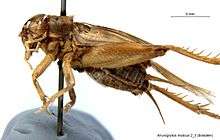Anurogryllus muticus
Anurogryllus muticus, also known as De Geer's short-tailed cricket[2] or simply short-tailed cricket (a name common to many Anurogryllus species) is a species of cricket in the family Gryllidae.
| Anurogryllus muticus | |
|---|---|
 | |
| Scientific classification | |
| Kingdom: | |
| Phylum: | |
| Class: | |
| Order: | |
| Family: | |
| Subfamily: | |
| Genus: | |
| Species: | A. muticus |
| Binomial name | |
| Anurogryllus muticus | |
| Synonyms | |
| |
It is native to Bermuda, the West Indies, Central and South America. It is nocturnal and hides in a burrow by day.
Taxonomy
At one time, nearly all the short-tailed crickets in the United States were considered to belong to the species Anurogryllus muticus, the range of which extended from Canada to much of South America. In a revision of the genus made by T. Walker in 1973, Anurogryllus arboreus was split off on the basis of the calling behavior of the male, and on certain morphological differences.[3] The range of A. muticus is now considered to include Bermuda, the West Indies, Central and South America as far south as southern Brazil while that of A. arboreus covers much of the continental United States.[1]
There are two subspecies; A. muticus caraibeus (Saussure, 1874) is found in the West Indies, the type locality being Saint Thomas, U.S. Virgin Islands, and A. muticus muticus (De Geer, 1773) which is found in Central and South America, the type locality being Suriname.[1]
Description
A. muticus is a small, pale brown cricket with a very short ovipositor.[4] The adults have wings, which is in contrast to A. arboreus which sheds its wings soon after maturing.[3]
Behavior
A. muticus is nocturnal, concealing itself in a burrow during the day. It forages at night and carries food into the burrow to side-chambers which it excavates. The entrance to the burrow is normally kept plugged except when its owner is outside.[4] Its preferred food seems to be the clover Alysicarpus vaginalis and the burrow is often constructed close to this food source.[5] This is particularly advantageous for females, which forage on this plant before egg-laying, transport time being minimised by its close proximity.[6]
Males of A. muticus call to attract a mate; the call is made during much of the night which is in contrast to A. arboreus which only calls for a period of two to three hours shortly after sunset.[7] Much energy is expended on calling and although the cricket metabolises both carbohydrates and lipids when at rest, while calling it mostly metabolises the lipids which have been stored in the testes.[8]
References
- "Species Anurogryllus muticus (De Geer, 1773)". Orthoptera Species File. Retrieved 2015-07-07.
- Walker, T. J. (1973). "Systematics and acoustic behavior of U.S. and Caribbean short-tailed crickets (Orthoptera: Gryllidae: Anurogryllus)" (PDF). Annals of the Entomological Society of America. 66: 1269–1277. doi:10.1093/aesa/66.6.1269.
- Costa, James T. (2006). The Other Insect Societies. Harvard University Press. pp. 104–. ISBN 978-0-674-02163-1.
- Walker, Thomas J. "Genus Anurogryllus". Singing Insects of North America (SINA). Retrieved 2015-07-06.
- Lee, How-Jing; Loher, Werner (1996). "Influence of age and environmental factors on burrow-making behavior of the short-tailed cricket, Anurogryllus muticus (De Geer) (Orthoptera: Gryllidae)". Journal of Insect Behavior. 95: 819–834. doi:10.1007/bf02213558.
- Lee, How-Jing (1989). Behavioral and Physiological Study of Reproduction in the Short-tailed Cricket, Anurogryllus muticus. University of California, Berkeley. p. 21.
- Gerhardt, H. Carl; Huber, Franz (2002). Acoustic Communication in Insects and Anurans: Common Problems and Diverse Solutions. University of Chicago Press. p. 261. ISBN 978-0-226-28833-8.
- Lee, How-Jing; Loher, Werner (1993). "The Mating Strategy of the Male Short-tailed Cricket Anurogryllus muticus de Geer". Ethology. 95 (4): 327–344. doi:10.1111/j.1439-0310.1993.tb00481.x.